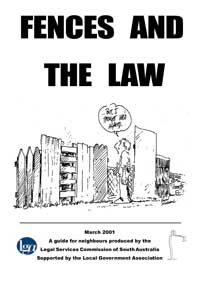Maintenance: Fence Notices

In this chapter we explain how the Fences Act is applied to Strata & Community titled groups.
Dealing with your neighbour over a shared boundary fence can cause some anxiety and tension.
The Fences Act covers any concerns arising from shared fences and disputes with neighbours. It clarifys procedures and forms, (Forms 1 to 3) as well as providing dispute resolution. The Act can be found on our web site.
Strata Corporations: For Strata Corporations the Fences Act applies only to the fences on the boundary of the group. Under Section 5 of the Strata Act the Corporation owns all the fences between the units, including gates.
Community Corporations: For a Community Corporation (lot beside lot) the fences between lots and on the external boundary of lots are the responsibility of the respective lot owners. All other fences are the Corporation’s responsibility to maintain. This means that the Fences Act applies to all fence works in the Corporation. Fences on community titled Strata Divisions (1 lot above another) are treated the same as a Strata Titled group. The corporation owns the fences between units and fences on the external boundary of the group.
Hint
Here are some hints if you, your group or a neighbour is planning to undertake some fence work:-
- If you want to put up a new fence and want your neighbour to contribute, you must serve on the adjoining owner a ‘Notice of Intention To Erect A Fence’ using Form 1.
- If you want to repair, replace or carry out maintenance work on the fence and want your neighbour to contribute, you must serve a ‘Notice of Intention to Replace or Repair a Fence’ using Form 2
All notices must be served on the adjoining owner, either by handing the Form to your neighbour personally or by sending them a letter containing the Form, by Registered Post. Leaving it in their mailbox, putting it under the door or sending it by ordinary post does not count, even if your neighbour actually receives it. Similarly, giving it to someone else who lives there, or a family member or tenant of your neighbour does not count. If you are not sure who the legal owner is, you can ask your local council or search at the Lands Titles Office. If there is more than one neighbour, you should serve a notice to all of them. Keep a copy of any notices you serve, and also a record of the date, time and method of service, in case your neighbour later states that they did not receive it.
Once the notice has been served on your neighbour, you must wait 30 days before starting any work. In this time the neighbour may object with a cross-notice, which may include counterproposals. This cross-notice should be written on Form 3.
If the adjoining neighbour agrees to your proposal, work can commence immediately. However, you should ensure that you have a signed agreement (agreement) before stating work, or wait for the 30 day notice period to expire.
If you receive no reply from the other owner after 30 days, it is considered that they have agreed with the proposed work and therefore you can commence the proposed works and claim your share of the cost from them. If you sent the notice by Registered Post, check with the post office to discover when your neighbour collected the notice. You should allow 30 days from this date, and also give at least two days notice of intention to commence fencing work.
OBJECTIONS AND COUNTER PROPOSALS
If you receive a Form 1 or 2 notice and you object to the proposal, you should complete a Form 3 cross-notice. This cross-notice must be served on the adjoining neighbour within 30 days of receiving the fencing notice. The same rules of service apply, as above. You do not have to give reasons for objecting – you may simply state “I object to your proposal”. Nor do you have to make a counter-proposal. However, if the case goes to court you will be required to tell the court of your objections to the proposed work. And, if you do not have good reasons, the court may order the work, and may also order you to pay court costs.
So, if you have a reasonable objection(s) to the suggested work it would helpful to state them in your cross-notice. If you want to suggest an alternative to what your neighbour proposed, you should do so, including details of the work and their cost. Your neighbour then has 30 days to answer your notice.
Hint
Have a chat with your neighbour before serving any cross-notice. Explore your concerns to see if it is possible to reach an agreement. If not, proceed to serve your cross notice Form 3.
The Court will not accept the following reasons in your cross-notice:
- you are about to sell your land and will not get the benefit of the proposed work. As long as you are the owner, the Fences Act procedure binds you. However, you may wish to tell your neighbour that you are selling, as they may agree to wait and deal with the new owner.
- you are not living at the place where the fence is to be built.
- inability to afford the suggested work. This will not stand up in court, particularly if the fence is in a poor condition and the work is obviously needed. If you agree that the work is required but you cannot afford to pay for it at this time, you should discuss terms of payment with your neighbour. If you cannot agree on a solution, consider using a mediation service.
- you don’t care about the state of the fence, or don’t think a fence is needed. The court normally considers it reasonable for neighbours to have a boundary fence and for that fence to be kept in a good state of repair. However, it may be proper to object if the proposed fence is quite different to other fences in your area.
If you have served a Form 1 or 2 and you receive a Form 3 cross-notice in reply, the same rules apply to you. If there are any counter-proposals that you disagree with, you must serve a written objection (Form 3 can be used) within 30 days. If necessary you can make a counter-counter proposal if you think that it will help to resolve the matter. If there are no counter-proposals in the cross-notice (that is, it contains an objection only) you do not have to reply – the notice procedure is finished without agreement or right to proceed.
If you receive a Form 1, 2 or 3 and do not object within 30 days, you will be legally bound to contribute to the proposal described on the form. This is true even if you have told your neighbour that you do not agree, or you believe that they are aware of this. Serving a Form 3 or a written objection is the only legally effective way of stating your disagreement.
For more details information on:
- No agreement
- Failure to proceed
- Power of entry
- Paying for fencing work
Download a copy of ‘Fences And The Law’ from our website.
Our thanks to the Legal Services Commission for contributing to this content.
Go to the Links page of our web site to view more helpful information from the Legal Services Commission
Tools
The following tools may assist:
|
Form 1 – notice of intention for a new fence |
Form 2 – notice of intention to repair fence |
|



